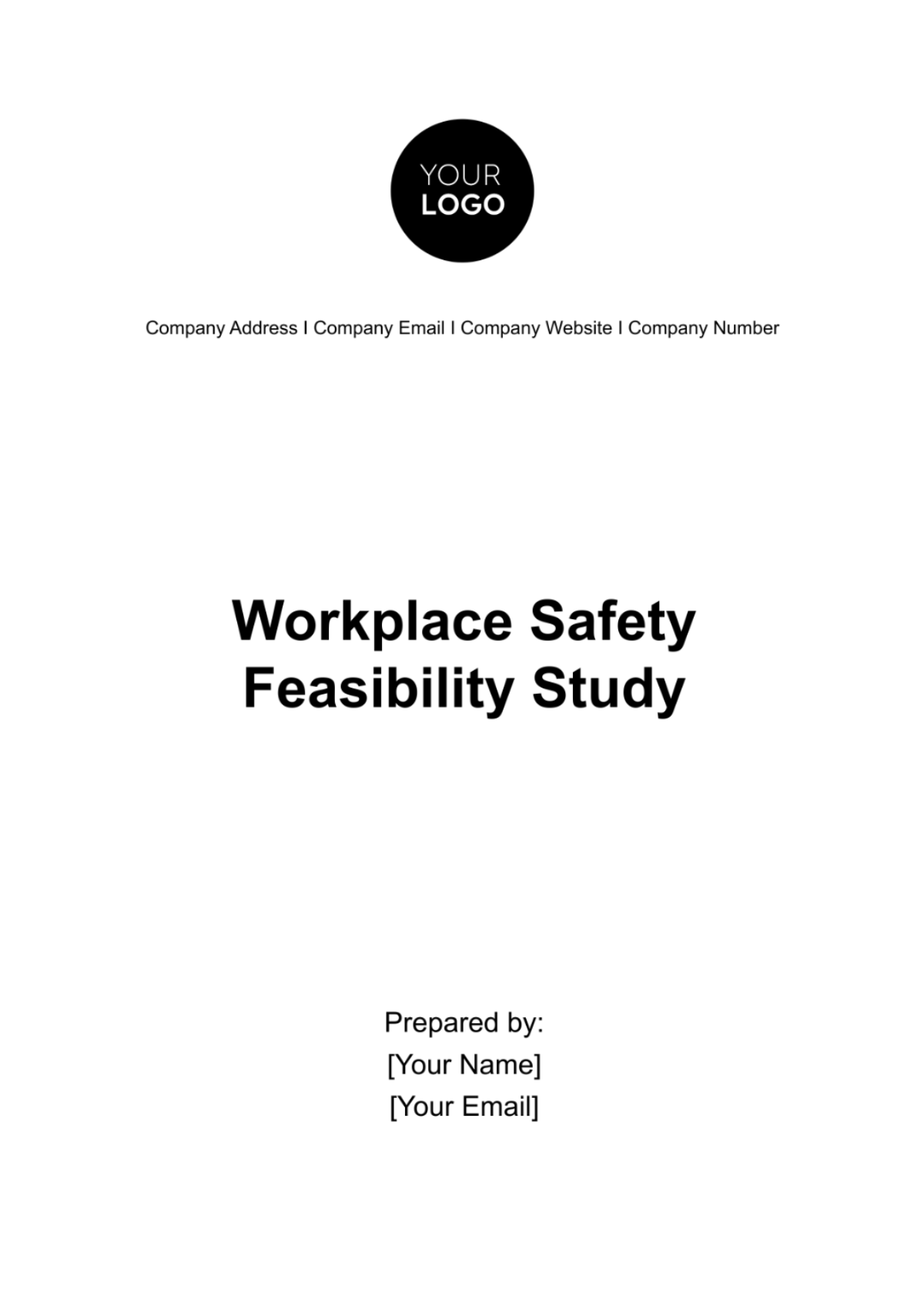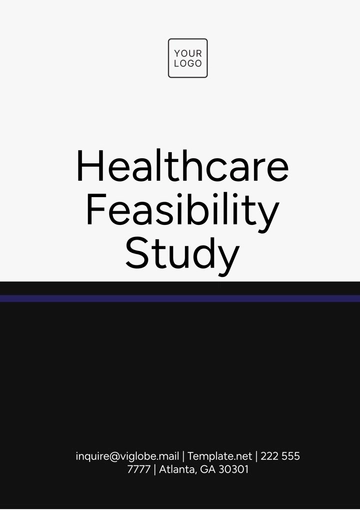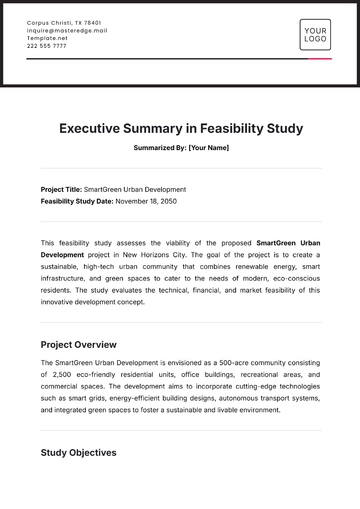Free Workplace Safety Feasibility Study

I. Executive Summary
The primary goal of this study is to evaluate the current workplace safety measures at [Your Company Name] and propose necessary improvements. The study involved a thorough review of existing safety policies, employee surveys, and a comprehensive risk assessment in various departments.
Based on the findings, recommendations include upgrading emergency response equipment, enhancing employee safety training, and introducing new safety monitoring technologies.
II. Introduction
In recent years, [Your Company Name] has witnessed significant changes in both internal and external environments impacting workplace safety. The industry has faced an array of challenges, including increased regulatory analysis and a series of safety incidents that have highlighted vulnerabilities within our current safety protocols. For instance, the incident on [Date] underscored the need for more robust safety measures.
Additionally, recent regulatory changes, mandate stricter compliance standards. These changes necessitates a reevaluation of our safety practices to ensure not only adherence to new regulations but also the safeguarding of our employees' well-being. The primary objectives of this feasibility study are multi-fold:
Identifying Safety Gaps: To systematically uncover areas in our safety protocols that are lacking or outdated, particularly in light of recent incidents and regulatory changes.
Ensuring Compliance: To verify that [Your Company Name]'s safety practices are in full compliance with the latest industry standards and legal requirements, thereby mitigating potential legal and financial risks.
Enhancing Employee Well-Being: To propose enhancements in our workplace safety measures that prioritize and improve the overall health and safety of our employees, fostering a safer and more productive work environment.
These goals aim to create a comprehensive understanding of our current safety stance and pave the way for effective enhancements.
Scope of the Study
This study covers a broad range of areas within [Your Company Name], focusing on departments identified as high-risk based on past incident reports and industry trends. The assessment period covers the past [2 years], providing a recent and relevant snapshot of our safety environment. The study will examine various types of risks, including physical hazards, ergonomic risks, chemical exposures, and emergency response capabilities.
By defining these parameters, the study aims to provide targeted insights and actionable recommendations, ensuring that the safety improvements we implement are both relevant and effective for our specific operational context.
III. Current Safety Analysis
Explore the current state of workplace safety at [Your Company Name], analyzing existing protocols and identifying prevalent risks.
A. Existing Policies Review
1. Compliance with Standards
a. Findings: A review of [Your Company Name]'s safety policies reveals a high level of compliance with OSHA standards. Regular updates keep policies aligned with industry norms.
b. Challenges: Some areas, particularly in new technology adoption, lag behind the latest safety standards.
2. Policy Implementation
a. Training and Awareness: Employees receive annual safety training, but ongoing awareness initiatives are limited, leading to gaps in day-to-day safety adherence.
b. Resource Allocation: Adequate safety equipment is provided, but some departments report shortages, impacting policy implementation.
3. Areas for Improvement
a. Up-to-Date Practices: Need to incorporate recent advancements in safety technology and practices.
b. Regular Audits: Implement more frequent safety audits to ensure continuous alignment with changing standards.
B. Employee Feedback
Summarizing feedback from employees about their perception of workplace safety and areas where they feel more support is needed.
1. Perception of Workplace Safety
a. Survey Insights: Employees generally feel safe but express concerns about emergency response preparedness.
b. Communication Gaps: Some employees are unaware of specific safety policies, indicating a need for improved communication.
2. Areas Needing More Support
a. Ergonomic Adjustments: Requests for better ergonomic equipment in office areas to prevent strain injuries.
b. Mental Health Support: Desire for more mental health resources, especially in high-stress departments.
C. Incident Analysis
Analyzing past safety incidents and near-misses to identify common trends and overlooked hazards.
1. Review Past Incidents
a. Common Incidents: Analysis reveals that slips, trips, and falls are the most frequent accidents, particularly in the warehouse and production areas.
b. Root Causes: Often linked to inadequate lighting and cluttered pathways.
2. Near-Miss Analysis
a. Reported Near-Misses: High occurrence of near-misses in machine operations, indicating potential risks.
b. Preventative Measures: Current measures are insufficient in addressing the identified risks, necessitating enhanced safety protocols.
IV. Regulatory Compliance Review
This section assesses how well [Your Company Name] adheres to relevant safety regulations, pinpointing areas where compliance is strong and where it falls short.
A. Regulatory Framework
Our operations intersect with a variety of health and safety regulations. These include, but are not limited to:
Occupational Safety and Health Administration (OSHA) Standards: Governing general workplace safety and specific guidelines for high-risk activities.
Environmental Protection Agency (EPA) Regulations: Pertaining to the management and disposal of hazardous materials.
Americans with Disabilities Act (ADA): Ensuring workplace accommodations for employees with disabilities.
B. Compliance Assessment
Detailed findings on compliance status in various areas, like equipment safety, employee training, and emergency preparedness.
1. Equipment Safety Compliance
a. Current Status: Most machinery and equipment meet OSHA standards. Regular safety inspections are conducted, and necessary safety guards are in place.
b. Concerns: Some older equipment in the manufacturing wing lacks the latest safety features recommended under current guidelines.
2. Employee Training Compliance
a. Current Status: Mandatory safety training is conducted annually, covering basic workplace safety and emergency response.
b. Concerns: The training does not comprehensively cover all specific risks associated with different departments. Attendance tracking for these sessions needs improvement.
3. Emergency Preparedness Compliance
a. Current Status: Emergency exits and evacuation plans are well-established and meet current standards.
b. Concerns: Lack of regular emergency drills and insufficient training on handling specific emergency situations like chemical spills.
C. Areas for Improvement
Identification of specific non-compliant areas along with suggestions for aligning with legal standards.
Equipment Safety Improvements | Upgrade older machinery to include the latest safety features. Implement a phased plan for these upgrades, prioritizing equipment with the highest risk. |
Enhancing Employee Training | Develop tailored training programs for different departments, focusing on the specific risks they face. |
Boosting Emergency Preparedness | Increase the frequency of emergency drills, ensuring they cover a variety of scenarios. Provide specialized training for handling incidents like chemical spills or electrical fires. |
V. Risk Assessment
A critical component, this section systematically identifies potential hazards and assesses the risks associated with them, providing a clear picture of safety vulnerabilities.
A. Hazard Identification
In the course of this study, several hazards within [Your Company Name]'s operations were identified. These include:
Chemical Exposure: Notably in the manufacturing and laboratory areas, where employees handle various chemicals.
Ergonomic Risks: Common in office settings, particularly with employees who spend extended periods at their workstations.
Electrical Hazards: Present in areas where electrical equipment is used or maintained, posing risks of shocks or burns.
Mechanical Hazards: Related to the operation of heavy machinery in the production department.
Environmental Hazards: Including poor air quality and excessive noise levels in certain workspaces.
B. Risk Evaluation
Hazard | Impact | Likelihood and Severity |
Chemical Exposure | Potential for acute injuries from spills and chronic health issues. | High likelihood in areas with inadequate ventilation or improper storage. |
Ergonomic Risks | Increased risk of musculoskeletal disorders. | Very likely over time, with moderate to severe long-term health impacts. |
Electrical Hazards | Risks of electric shocks, burns, and in severe cases, fatal accidents. | Moderate likelihood but with potentially severe to fatal consequences. |
C. Risk Prioritization
Prioritizing risks based on their evaluation, to focus on the most critical areas first.
High Priority | Chemical exposure and electrical hazards are deemed high priority due to their potential for severe health impacts and the relatively higher likelihood of occurrence. |
Medium Priority | Ergonomic risks, while having a high likelihood of occurrence, are given a medium priority due to their generally less immediate, but still significant, impact on health. |
Lower Priority | Mechanical and environmental hazards are categorized as lower priority, not due to their lack of importance, but because existing controls already mitigate these risks effectively. |
VI. Safety Improvement Proposals
Based on the identified risks and compliance gaps, this section proposes targeted improvements to enhance workplace safety effectively.
A. Strategic Measures
To address the identified risks at [Your Company Name], several strategic measures are proposed. These include the introduction of advanced safety equipment like chemical spill containment kits in the laboratory, revising emergency response protocols to incorporate recent industry best practices, and remodeling workspaces to enhance ergonomic safety.
Additionally, upgrading electrical safety equipment and implementing regular safety audits across all departments are recommended to systematically identify and mitigate potential hazards.
B. Justification for Each Proposal
The introduction of advanced safety equipment is justified by the high risk associated with chemical handling, aiming to minimize exposure and spill incidents. The revision of emergency protocols responds to the evolving nature of workplace risks and ensures alignment with the latest safety standards.
Remodeling for ergonomics is driven by the increasing incidents of work-related musculoskeletal disorders, aiming to enhance employee well-being and productivity. Electrical safety upgrades are a response to the identified electrical hazards, and regular safety audits ensure continuous oversight and improvement of workplace safety practices.
C. Cost-Benefit Analysis
The cost of implementing these safety improvements, while significant, is outweighed by the potential benefits. The investment in advanced safety equipment and protocol revisions is expected to reduce the incidence and severity of workplace accidents, leading to lower medical costs and decreased downtime. Ergonomic improvements in workspaces are anticipated to reduce long-term health-related absences, thereby enhancing productivity.
Regular safety audits, though an ongoing expense, provide an invaluable benefit by ensuring continuous compliance and safety, potentially reducing legal liabilities and enhancing the company's reputation for safety. Overall, the long-term benefits in terms of reduced risks, improved compliance, and enhanced employee well-being justify the initial investment.
VII. Implementation Plan
This actionable segment lays out a strategic plan for implementing the proposed safety improvements, detailing the steps, timeline, and responsibilities.
A. Implementation Steps
The implementation of proposed safety improvements at [Your Company Name] involves a structured approach:
B. Timeline
The timeline for implementing the proposed safety improvements is as follows:
[Months 1-2] | Initial Assessment and Planning |
[Months 3-4] | Resource Allocation |
[Months 5-6] | Training and Protocol Development |
[Months 7-8] | Implementation of Safety Measures |
[Months 9-10] | Training and Awareness Campaigns |
[Months 11-12] | Monitoring and Evaluation |
C. Roles and Responsibilities
For effective implementation, specific responsibilities are assigned as follows:
Safety Manager | Oversee the entire implementation process, including initial assessments, resource allocation, and monitoring. |
Procurement Team | Responsible for acquiring the necessary safety equipment and materials. |
Human Resources | Develop and administer training programs, and lead awareness campaigns. |
Facilities Management Team | Implement physical changes in the workplace, such as ergonomic adjustments and equipment installations. |
Department Heads | Ensure compliance within their teams, provide feedback on implementation progress, and facilitate employee participation in training programs. |
VII. Financial Analysis
This essential section provides a detailed financial breakdown of the proposed safety improvements, analyzing the investment required and its long-term impact.
1. Budget Breakdown
Equipment Costs: Purchasing new chemical spill containment kits and advanced electrical safety equipment is estimated to cost [$20,000]. This includes all necessary tools and protective gear.
Training Expenses: Developing and implementing new safety training programs across various departments is projected to cost [$15,000]. This covers materials, external trainers' fees, and employee time.
Renovation/Modification Costs: Remodeling workspaces for ergonomic improvements is estimated at [$30,000], which includes ergonomic chairs, adjustable desks, and other necessary modifications.
The total estimated budget for these safety improvements is [$65,000]. This budget plan ensures that all aspects of safety upgrades are financially accounted for.
2. ROI Analysis
Analysis of the Return on Investment, considering factors like potential reduction in incident rates and improved efficiency.
Reduction in Incident Rates: By investing [$65,000] in safety improvements, we anticipate a [40%] reduction in workplace incidents, leading to lower medical and legal costs.
Improved Efficiency: Enhanced safety measures and ergonomic improvements are expected to increase employee efficiency, potentially boosting productivity by [15%].
Long-Term Financial Benefits
Projecting long-term financial benefits such as lower insurance premiums, reduced absenteeism, and increased productivity.
Lower Insurance Premiums: Implementing durable safety measures can lead to a reduction in insurance premiums due to fewer claims, potentially saving [Your Company Name] up to [10%] annually.
Reduced Absenteeism: Improved safety and ergonomics are expected to reduce absenteeism by [25%], leading to consistent workforce availability and productivity.
IX. Conclusion and Recommendations
This final section summarizes the study's findings and articulates clear, actionable recommendations for [Your Company Name].
Key Insights from the Safety Feasibility Study:
The study highlighted critical risks, including chemical exposure in laboratories and manufacturing areas, ergonomic risks in office settings, and electrical hazards across various departments.
There are substantial opportunities to enhance safety, particularly in the areas of emergency preparedness, employee training, and ergonomic workplace design.
The assessment revealed gaps in compliance with current safety regulations, indicating a need for immediate action to avoid potential legal repercussions.
These findings highlight the urgent need for comprehensive safety enhancements at [Your Company Name] to protect employees and ensure regulatory compliance.
Recommended Action Items or Safety Recommendations:
Invest in advanced safety equipment, particularly for chemical and electrical hazard management.
Develop and implement more comprehensive, department-specific safety training programs.
Undertake a project to remodel workspaces, focusing on ergonomic improvements to reduce strain injuries.
Regularly conduct emergency drills and update emergency response protocols.
Address identified regulatory compliance issues by updating policies and procedures in line with current safety standards.
These recommendations should be prioritized by [Your Company Name] to effectively mitigate identified risks and capitalize on opportunities to improve workplace safety.
- 100% Customizable, free editor
- Access 1 Million+ Templates, photo’s & graphics
- Download or share as a template
- Click and replace photos, graphics, text, backgrounds
- Resize, crop, AI write & more
- Access advanced editor
Introducing the Workplace Safety Feasibility Study Template from Template.net. Crafted with precision, this editable and customizable template simplifies safety assessments. Utilize our intuitive Ai Editor Tool to streamline your study process. Elevate workplace safety with ease and efficiency. Get started today with Template.net.





























